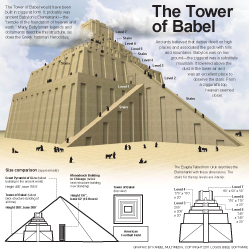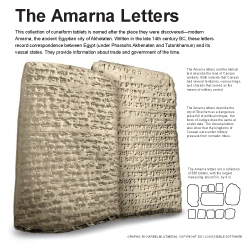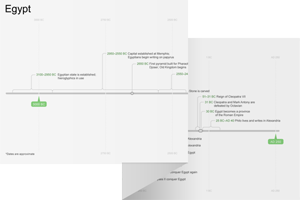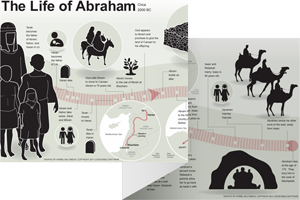11:1–9 Although the Table of Nations in Gen 10 describes the descendants of Noah spread out across the world, the story of the Tower of Babel returns the narrative to a time before that scattering of peoples. The story recounts how the post-flood population initially tries to stay together in one place and build a tower to reach heaven. |
 Understanding the Table of Nations
Understanding the Table of Nations
11:1 the whole earth This refers to the ancient Near East and the Mediterranean world. Since ch. 11 and its dispersion of the nations is linked to the Table of Nations of ch. 10, which is specific to people groups of the ancient Near East, this phrase should not be understood to refer to entire world (see note on 10:1–32).
one language and the same words The belief in one language is found elsewhere in ancient Near Eastern literature, but there is not a precise parallel to this episode. Modern linguistic research cannot establish evidence for a single human language from which all others derive. Evidence indicates that a small number of unaffiliated languages can collectively produce the world’s languages of today.
11:2 people migrated from the east Following the time of the flood, people are described as nomadic.
from the east The Hebrew text here can be rendered either “from the east” or “eastward.” A migration to the east makes sense: from the Ararat (Urartu) region (see 8:4 and note) to Babylon (Shinar)—the setting of the tower story.
the land of Shinar This refers to the land of Babylonia, which encompasses the city states of Sumer
which encompasses the city states of Sumer and Akkad
and Akkad and extends northward to Assyria.
and extends northward to Assyria. This name does not occur in Mesopotamian material but appears many times in Egyptian and Hittite records, as well as the Amarna Letters.
This name does not occur in Mesopotamian material but appears many times in Egyptian and Hittite records, as well as the Amarna Letters.
11:3 brick for stone and they had tar for mortar A brief description of the tower’s construction which shows that Mesopotamians had a solid grasp of building techniques.
11:4 let us build ourselves a city and a tower The tower was not the only thing that would enable the people to remain together rather than spread over the earth—the city was also essential. The tower spoken of here was a ziggurat temple, a massive brick, stepped tower that dominated the landscape.
whose top reaches to the heavens This description is commonplace in Mesopotamian ziggurat inscriptions.
a name The Hebrew word used here, shem—which is primarily used as a designation of identity—is also used in the ot and Mesopotamian literature to refer to something gaining renown or reputation. See Prov 22:1; Eccl 7:1; Neh 6:13; Ruth 4:11; Jer 32:20; 2 Sam 7:9.
we be scattered over the face of the whole earth Towers (or ziggurat temples) and their associated cities were the heart of economic distribution systems in ancient Mesopotamia. The goals of building both—which this passage clearly presents—amounted to the rejection of God’s command and blessing in Gen 9:7.
11:5 Yahweh came down to see This description follows the pattern seen throughout Genesis of portraying Yahweh as involved in the affairs of humanity. This line is also ironic: While the humans sought to build a tower into the heavens (v. 4), Yahweh must come down to it. The same anthropomorphic phrase occurs in 18:21 in connection with Sodom and Gomorrah, where God already knows the evil in the city (18:17).
11:6 one people Not ethnic identity (see ch. 10), but unity.
11:7 let us go down As with 1:26, this exhortation is plural. The plural indicates that Yahweh is speaking to the heavenly host or divine council (see 1:26 and note).
 Plural Pronouns in Genesis 1:26
Plural Pronouns in Genesis 1:26
11:8 Yahweh scattered them This dispersal will eventually result in the fulfillment of Yahweh’s command after the flood (9:7), but at a terrible price. This event is central to understanding how nations came to worship other gods besides Yahweh who had created them (see chs. 1–2). This is where Yahweh shifts from focusing on all the peoples of the earth to electing Israel (see 12:1–3). In a sense, the Babel event marks Yahweh disowning the nations of the world as His human family in favor of electing Israel, whom He will also use to reclaim the nations as His people (Deut 32:8–9; 4:19–20; compare Isa 2:1–5; Hos 1:8–11).
 Deuteronomy 32:8 and the Sons of God
Deuteronomy 32:8 and the Sons of God
11:9 its name was called Babel Here, Hebrew wordplay connects God’s confusion of language with the name for the place. The Hebrew word balal (“to confuse”) and the Hebrew name Babel (bavel) sound similar.
11:10–26 This genealogy of Shem differs from that of 10:21–31. It focuses only on firstborn sons and is more detailed than the one in ch. 10. As result, a number of names in this genealogy do not appear in 10:21–31. The genealogy highlights Shem in anticipation of Abram (Abraham) who is Shem’s descendant and the patriarch with whom the genealogy culminates. In the genealogy, Abram is the 10th generation from Shem, just as Noah was the 10th generation from Adam. This indicates that the genealogy is highlighting a specific point: As with the birth of Adam and Noah, the birth of Abram represents a turning point in human history. |
11:10 the generations of The Hebrew term used here, toledoth, marks family histories in Genesis. See note on 5:1.
Shem was one hundred years old This number is approximate since the information in 5:32 and 7:6 indicates Shem would have been 102 years old at this point.
Arphaxad This figure is listed as the firstborn of Shem here, but in 10:22 he is listed third. The account here seems to reflect birth order, while the genealogy in ch. 10 seems to change the birth order because it is focused on the geographical distribution of people groups.
11:14 Eber The eponymous ancestor of the Hebrew people (the one whom the people group derives its name from, according to this account). See 10:21 and note.
thirty years Eber is the last of the patriarchal ancestors to live more than four centuries. The lifespans of the six generations listed after Eber are about half the length of the first four generations after Noah.
11:16 Peleg The line of Shem described in 10:21–31 follows the line of Joktan, Peleg’s brother. The line of Peleg is resumed here, leading to Abram. See note on 10:25.
11:18 Reu This descendant of Shem was not mentioned in the earlier genealogy. In the Bible, this name appears only in genealogies (1 Chr 1:25; Luke 3:35).
11:20 Serug Several of Abram’s ancestors have names that correspond to cities in Mesopotamia. Serug is the name of a place west of Haran in northwestern Mesopotamia.
11:22 Nahor Abram’s grandfather and brother (Gen 11:26) are both named Nahor. A city known as Nahur is located not far from Haran in northwestern Mesopotamia.
11:24 Terah Assyrian sources mention a place name near Haran that includes the word turachi—this likely corresponds to this name (see v. 32).
11:26 Abram The genealogy ends by introducing Abram (Abraham), the next major character in the narrative. The ch. 5 genealogy similarly ends with Noah (see 5:32), the main character of chs. 6–9.
The name Abram is consistently used until God changes his name to “Abraham” |
Nahor Rebekah, who marries Abram’s son Isaac, is the granddaughter of this brother of Abram (24:15).
Haran The name of this brother of Abram and Nahor is not related to the similar sounding (in English) place name in v. 32.
11:27–32 This short section introduces the narratives about Abram (Abraham) and his family. The genealogies in Genesis have so far followed a pattern of 10 names between important figures (e.g., Adam to Noah, Noah to Abram). This paragraph includes eight names, possibly foreshadowing the central theme of Abram’s story—that the list will become complete again with the birth of Isaac, the child of promise. The ninth and 10th family members are Abram’s sons Ishmael and Isaac. |
11:27 Lot The origin of his name is unknown.
Lot was the son of Haran and grandson of Terah (see v. 31). After his father dies, he aligns himself with his uncle, Abram, and accompanies him on his migrations. Lot plays an important role at several decisive points in the Abraham narratives. First, Lot accompanies Terah and the rest of the clan from Ur to Haran (v. 31). Later, he accompanies Abram to Canaan (12:5). After they arrive in Canaan, Lot leaves Abram and moves into the Jordan Valley (13:11–12)—a decision that places Abram in the heart of the land that God has promised him. Lot’s choice also places him in harm’s way, and twice Abram intervenes to save him (14:1–16; 18:22–33). Throughout the Genesis narrative, Lot is characterized by the questionable choices he makes; this stands in contrast to Abram’s persistent faith. The final story about Lot describes his flight with his two daughters after the destruction of Sodom. Fearing they are the last people on earth, his daughters get Lot drunk, get pregnant by him, and bear sons (19:30–38). This shameful story explains the origins of the Moabites and the Ammonites, nearby enemies of Israel. Later traditions viewed Lot as a righteous in some way, due to his association with Abraham (2 Pet 2:7). |
11:28 Ur of the Chaldeans Possibly a Sumerian coastal city-state near the Persian Gulf in southern Mesopotamia. Alternatively, another Ur is located in the northwest region of Mesopotamia in proximity to Anatolia (land of the Hittites) and Syria.
11:29 Sarai The name of Abram’s wife is changed to Sarah in Gen 17:15.
Milcah and Iscah These are the daughters of Haran. Only Milcah is significant in the narrative as the grandmother of Rebekah, who becomes the wife of Isaac (22:20, 23).
11:30 Sarai was barren Barrenness provides the central drama of the narrative about Sarai (Sarah) and Abram (Abraham).
11:31 Haran A city on the upper Euphrates River in northwestern Mesopotamia. The city is mentioned later in the list of places conquered by Sennacherib, king of Assyria (2 Kgs 19:12).
11:32 Terah died in Haran This explains the circumstances of Gen 12:1–6.

|
About Faithlife Study BibleFaithlife Study Bible (FSB) is your guide to the ancient world of the Old and New Testaments, with study notes and articles that draw from a wide range of academic research. FSB helps you learn how to think about interpretation methods and issues so that you can gain a deeper understanding of the text. |
| Copyright |
Copyright 2012 Logos Bible Software. |
| Support Info | fsb |
 Loading…
Loading…





 Abram (Abraham)
Abram (Abraham)